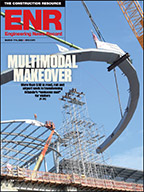March Construction Starts Climb 7% Nationwide
Nonbuilding construction, at $136.5 billion (annual rate), increased 6% in March. Support for the nonbuilding total came from a 170% jump for electric utilities, which included the March start of three very large projects—a $1.2-billion natural gas-fired power plant in Florida, a $364-million natural gas-fired power plant in Oregon and a $350-million wind power facility in Maine.
The public works categories overall in March retreated 8% as the result of a 53% drop for miscellaneous public works (site development, pipelines, mass transit) and a 10% slide for water supply construction. The other public works categories showed growth in March relative to February. Bridge construction climbed 45%, boosted by the start of the $585-million Gerald Desmond
Bridge Replacement project in Long Beach, Calif. Highway construction in March increased 26% and included a $109-million lane widening project in Texas.
Through the first three months of 2014, the top five states ranked by the dollar amount of new highway and bridge projects were Texas, California, North Carolina, Pennsylvania and Virginia. Gains were also reported in March for sewer construction, up 17%; and river/harbor development, up 11%.
Residential Building
Residential building in March settled back 2% to $208.6 billion (annual rate). The multifamily side of the housing market retreated 9% from its elevated February amount, although March was still 17% above the average monthly pace for multifamily housing during 2013. The large multifamily projects that were reported as March starts were located primarily in the Northeast, including a $400-million apartment building in New York City, a $330-million apartment building in Brooklyn, N.Y., a $144-million apartment building in Jersey City, N.J., and a $74-million apartment complex in Westwood, Mass.
Single-family housing in March was essentially unchanged from February, and since the most recent peak was reached in October 2013, construction activity has been flat or down for five straight months. By geography, March showed slight gains in the Midwest (up 4%), the South Atlantic (up 2%), and the Northeast and South Central (each up 1%), while the West retreated (down 6%).
Murray noted, “The soft pattern for single-family housing has probably been the result of tough weather conditions in recent months, so it’s expected that construction will pick up during the second quarter, given tight inventories of new homes for sale and what are still low mortgage rates,” he said. “At the same time, the limits of the single-family housing recovery are becoming more apparent, including constrained demand as the result of strict bank lending standards and the preference by some segments of the millennial generation for apartments in urban locations.”
The 2% decline for total construction starts on an unadjusted basis during the first three months of 2014 relative to last year was due to a mixed performance by major sector—nonresidential building, down 4%; residential building, up 3%; and nonbuilding construction, down 8%. By geography, the pattern of total construction starts for the January-March period of 2014 was the following—the South Central, down 9%; the Midwest, down 7%; the South Atlantic, down 4%; the West, up 4%; and the Northeast, up 8%.
Additional perspective comes from looking at 12-month moving totals, in this case the 12 months ending March 2014 versus the 12 months ending March 2013.
On this basis, total construction starts were up 6%, as the result of this behavior by major sector—nonresidential building, up 7%; residential building, up 18%; and nonbuilding construction, down 8%.
By geography, the 12 months ending March 2014 revealed the following for total construction starts compared to the previous 12 months—the Northeast, up 15%; the West, up 9%; the Midwest, up 7%; the South Atlantic, up 3%; and the South Central, unchanged.


